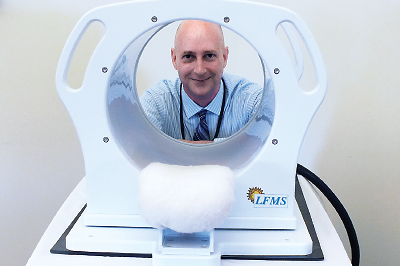New paradigms in psychiatric therapy do not come along very often. As Linda Carpenter, M.D., a professor of psychiatry and human behavior at Brown University and a member of APA’s Council on Research said, “For decades psychiatrists have basically relied on two tools to treat depressive disorders, talk therapy and antidepressant medication. In rare cases electroshock therapy was an option when nothing else worked, but that came with significant risks.”
Researchers started envisioning a Holy Grail of sorts, a device that could be as effective as electroconvulsive therapy (ECT), but without the negative consequences like seizures and possible memory loss. Exposing the brain to a series of strong magnetic pulses, known as repetitive transcranial magnetic stimulation (rTMS), has shown some promise in relieving depression, but it also carries a risk of unpleasant effects.
A recent study by researchers at McLean Hospital, published August 1 in Biological Psychiatry, suggests that turning down the magnetism may provide the best of both worlds.
Led by Michael Rohan, Ph.D., a principal investigator at McLean’s Brain Imaging Center, researchers found that a single 20-minute session of low-field magnetic stimulation, or LFMS, could improve the mood of patients with major depressive or bipolar disorder, without any unpleasant physical sensations. And unlike ECT or rTMS, which can take days or even weeks before mood improvements are manifest, LFMS works immediately.
Whereas current methods of electromagnetic brain stimulation jolt nerve fibers into action through high-strength, low-frequency waves, LFMS emits high-frequency waves at a fraction of the strength. “The LFMS signal is too weak to directly stimulate nerve fibers, so it operates on some completely different mechanism,” Rohan said. “We don’t know the exact mechanism, but any brain changes induced by a low magnetic field would have to occur near the synapses between nerves.”
To learn more, he plans on conducting follow-up studies in which patients receiving LFMS also have electroencephalography (EEG) recordings taken so their brain activity can be monitored during the process.
Rohan is also testing whether LFMS provides a long-term benefit by giving participants three daily treatments then following up one week later. “If the effects last a week, that already puts us in the ballpark where LFMS could be used as a maintenance therapy,” Rohan said.
Even if the mood improvement is only transient, Rohan still sees clinical potential for LFMS therapy. “I envision these devices would be worthwhile in emergency rooms; if a patient arrives in crisis, the LFMS can stabilize their mood right away and keep them calm until longer-term treatments take effect.”
Discovery Was Stroke of Good Fortune
Rohan’s current success is the culmination of a decade-long journey that began with a study designed to measure the effect of certain medications on bipolar disorder. The participants in that study, which Rohan was not initially a part of, were given scans in a magnetic resonance imaging (MRI) machine that had been modified so the magnetic pulses could measure chemical changes in the brain.
“I have to give the credit to Aimee Parow, who at that time was a pre-med student assisting on that study,” Rohan said. “She was the first to notice that people left their MRI session saying they felt better, and she brought it to the attention of the imaging-center director, Perry Renshaw, as something unexpected.”
Renshaw agreed that it was a connection worth pursuing, and Rohan was brought in. The protocol was adjusted to include mood ratings as a measurement, while also adding a control group in which bipolar patients received a regular MRI. Twenty-three out of 30 subjects given the experimental scan, known as echo-planar magnetic resonance spectroscopic imaging (EP-MRSI), reported an immediate improvement in mood, compared with only 3 out of 10 given a standard MRI.
As Rohan recalls, that study—published in the American Journal of Psychiatry in 2004—was a media hit. “I still have a copy of a news story from Bangladesh,” he said. “Of course, the news all focused on the novelty that this worked in an MRI, which was irrelevant.”
The relevant matter was identifying which component of the EP-MRSI scan produced these antidepressant effects. Rohan hypothesized that low-energy signals were responsible and built a prototype low-field device to test in animal models. Once that proved successful, the next step was designing a model suitable for human use. In 2007, his tabletop LFMS device, which looks like a mailbox, was finally ready to begin the gold standard of tests, a randomized, double-blind, control study.
“There’s a lot of excitement among people participating in a new therapy, so the placebo effect is pretty high,” Rohan explained. “It’s important to factor that in, especially in mood studies.”
However, it’s difficult to get a true sham group in an electromagnetic study, as a strong electric or magnetic pulse can induce physical sensations. It’s not ethical to knowingly inflict discomfort on someone with no potential benefit, but if a study subject feels nothing, he or she might suspect that they’re in the control group, he noted. A low-energy magnetic pulse, though, alleviates this worry.
The study did take some time, but the end result was worth it. Under carefully controlled conditions, Rohan managed to reproduce the rapid antidepressant effect he had seen a decade earlier.
Breakthroughs on Horizon
Even as Rohan was conducting his study, word of LFMS was spreading.
“I have a number of collaborators at Massachusetts General Hospital, and through that connection I followed the evolution of this new technology,” said Richard Shelton, M.D., the Charles B. Ireland Professor of Psychiatry at the University of Alabama, Birmingham (UAB), and head of the Mood Disorders Research Center.
Shelton was already working with rTMS, which has the ability to shape the magnetic field so the energy can be guided to specific parts of the brain. The downside of this precision is that the machines are costly and complex, which puts them out of reach for most consumers.
LFMS is simpler in that it generates a nonspecific energy field, and Shelton saw the potential of this device to become readily available for a variety of clinical settings.
The National Institute of Mental Health shared this assessment and selected LFMS as the inaugural study in its Rapidly-Acting Treatments for Treatment-Resistant Depression (RAPID) program, aimed at identifying new modalities that work in 72 hours or less. The RAPID study used a device built by a private company in Boston that had licensed Rohan’s technology. Shelton and UAB were one of the six sites chosen to carry out the study, which is ongoing.
“The safety and efficacy profiles of LFMS are extremely promising,” Carpenter told Psychiatric News, “but what will really open up the field is that next-generation devices are becoming portable.”
“If you could take a daily pill to manage your symptoms, why would you want to drive to a specialty clinic for a daily session of TMS?”
Carpenter herself is involved in a clinical study for a new technique known as synchronized transcranial magnetic stimulation (sTMS). While traditional magnetic stimulation involves conducting electricity through a coil to create a magnetic field, the sTMS device uses three rare earth magnetic balls, (akin to buckyballs). These spherical magnets are rotated by little motors, creating a weak magnetic field.
The other unusual feature of sTMS is that the magnetic field can be synchronized to each patient. The device has small electrodes that can read alpha waves, weak signals that emanate from the brain when someone is awake and relaxed. The magnetic output can then match the alpha wave frequency, to hopefully produce a more enhanced effect.
It may have a new-age feel to it, but if the synchronization works—and early results presented at scientific conferences have been positive—sTMS could usher in a new wave of customized treatments for mood disorders.
“Things have been pretty stagnant for a while in regard to treating mood disorders,” Shelton said, “and this field is ready for a new paradigm. These advances in electromagnetic therapy could definitely change the algorithm for how we treat mood disorders.”
Rohan’s recently published LFMS study was funded by the Stanley Medical Research Institute; his continuing study is being sponsored by the Depressive and Bipolar Disorders Alternative Treatment Foundation. Carpenter’s ongoing clinical study of sTMS is being funded by NeoSync. ■
An abstract of “Rapid Mood-Elevating Effects of Low-Field Magnetic Stimulation in Depression” can be accessed
here. An abstract of the 2004 study, “Low-Field Magnetic Stimulation in Bipolar Depression Using an MRI-based Stimulator,” is available
here.

